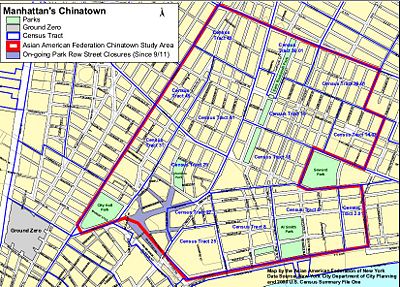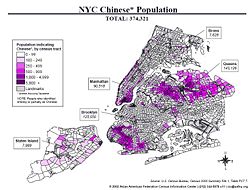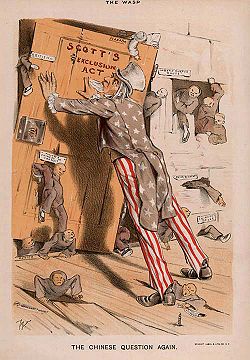From The Peopling of New York City
Contents |
Detailed Map
Location and Size
The actual size of Chinatown is difficult to approximate because its border is heavily overlapped with other neighborhood surrounding Chinatown. Roughly speaking, Chinatown is an area one mile in the North-South direction stopping at Delancey Street in the North, bordering SoHo and East Village, and reaching Chambers Street in the South, encroaching the City Hall are. It expands to two miles in the East-West direction between Broadway and East Broadway stopping at Rutgers Street. [1]
Statistics
| Population | |
|---|---|
| 2000 Total Population | 84,840 |
| 2000 Asian Population | 55,864 |
| Asian Population as a Percentage of the Total Population | 66% |
| Immigration | |
| 2000 Total Foreign-Born Population | 50,141 |
| Foreign-Born Percentage of General Population | 59% |
| 2000 Asian Foreign-Born Population | 44,583 |
| Educational Attainment (Adults 25 and Older) | |
| Number of Adults Without a High School Diploma | 35,721 |
| Percentage of Adults Without a High School Diploma | 60% |
| Number of Asian Adults Without a High School Diploma | 27,189 |
| Percentage of Asian Adults Without a High School Diploma | 70% |
| Limited English Proficiency (Speaks English “NotWell” or “Not at All”) | |
| Age 18-64 | 34,474 |
| 65 and Older | 8,233 |
| Household Income | |
| Number of Households Earning Less Than $20,000 | 13,544 |
| Percentage of Households Earning Less Than $20,000 | 45% |
| Number of Households Earning More Than $100,000 | 1,950 |
| Percentage of Households Earning More Than $100,000 | 6% |
| Poverty | |
| Number of Individuals Living in Poverty | 25,755 |
| Percentage of Total Population Living in Poverty | 31% |
| Number of Elderly (Over the Age of 65) Living in Poverty | 4,573 |
| Percent of Elderly Living in Poverty | 40% |
| Number of Children (Under 18) Living in Poverty | 6,025 |
| Percent of Children Living in Poverty | 35% |
Overview
Chinatown is the largest area of its kind in the United States. Located on the lower east side of Manhattan, the region is defined by Kenmore Street and Delancey Street on the north side, East and Worth Streets on its south side, Broadway on the west, and Allan Street on the east. Chinatown has not only expanded in terms of its current-day borders (as mentioned above), but it has also grown culturally. Today, it is home to other groups of immigrants, including Dominicans, Puerto Ricans, Vietnamese, and Filipinos. [3]
History of Immigration
Immigration initiated from the late 1870s. Though the Exclusion Act of 1882 was enacted to slow down immigration, the Chinatown of Manhattan expanded. It has grown from 1965, when the quotas for immigration were abolished.[4]
What attracted Chinese to the United States initially was the rush for gold that was occurring in the 1840s and 1850s. Additionally, cheap labor was needed to build the Central Pacific Railroad. These opportunities only increased Chinese immigration. However as immigration was growing, a sense of tension arose as the chance of competition grew. As a result racism was common against the Chinese population and led many to migrate to other regions. The Five Points area became home to a small but thriving Chinese population.
Underground Economy
In Chinatown, from the early 1900s, an underground economy developed. Workers without documents worked illegally within the few mile radius where they lived. Even today, its businesses are secretly controlled by gangs. Though some businesses have been shut down by authorities, illegal work continues through other outlets. This includes making the underground economy mobile through people physically selling merchandise on the streets.
The Bachelor’s Society
Chinatown held a disproportionately large amount of males. In 1900, there weren’t more than 150 women residing in the Chinese population of 7000 in Chinatown. Speculation that arose as a result of this ratio such as the idea of prostitutes, and slave girls, only created more negativity for the community.
Enclave Formation
The reasons as to why an enclave formed was due to the discrimination directed towards the Chinese immigrants. There was also segregation within the Chinese population.
Attractions
Some of the well known sites of Chinatown include[5]:
* Chatham Square * Columbus Park * Five Points * Museum of the Chinese in the Americas * Church of the Transfiguration * Mahayana Buddhist Temple * First Shearith Israel Cemetery * Edward Mooney House
Chinatown doesn’t only have the commercial façade that appears initially. It is filled with attractions that hold a significance to the members of the community. Columbus Park, created in the 1890s, is where you can see many performing tai chi exercises, or playing mahjong. It is the largest landscape of its kind in Chinatown (biggest park area). Chatham Square/Kim Lau Square (located off of Bowery and Worth Street) is where the statue of Lin Xe Zu and a monument for Chinese soldiers are erected. It is a memory for the Chinese soldiers who perished during World War II. Confucius Plaza is located just east of Chatham Square. The Church of Transfiguration, built in 1801, not only holds aesthetic beauty, is New York City’s oldest Catholic Church. It also houses a school so that people of all ages can utilize its facilities. The church meshes together Chinese, Italian, and Irish cultures. In other words, it has served Irish, Italian, and Chinese immigrants. It is an incredibly helpful institution because it helps new immigrants to integrate into their communities much better. The Mahayana Buddhist Temple is where one can see the Great Buddha Statue, which stands at over sixteen feet high. One has to go within its depths to be able to see this statue, however. The temple is New York City's largest Buddhist temple, and not only contains tranquil religious spaces on the lower level, but also houses a gift shop. For a dollar, you can even get your fortune. The temple holds a close place in some visitors' hearts because of the statue inside- this is where people can place offerings for their deceased loved ones. Mott Street, the first Chinese street of New York, can also be found here, where both the Mandarin and Cantonese dialects can be heard. It houses the oldest Chinese shops, dating back to the 1890s. Five Points (the intersection of Mosco, Worth, and Baxter Streets) is located at the south side of Columbus Park. Historically, it contained the tenements that were the homes of German and Irish immigrants.[6]
Expansion:
Although Chinatown started off with a small population, the Exclusion Act repealed in 1943 and growth began. While the number of people increased, the number of dominantly Chinese businesses (including mainly hand-laundry and restaurant businesses) grew as well. A quota was still in effect at this time, however, which placed a strain on Chinese immigration. The quota, however, was also repealed, in 1968. This was when the population boom really occurred. Chinatown expanded further, even pushing into the limits of a nearby neighborhood, Little Italy. Chinatown’s popularity has since grown, attracting thousands of tourists, all lined up to explore its thriving businesses. [7]
References
- ↑ "Chinatown, Manhattan". Wikipedia. <http://en.wikipedia.org/wiki/Chinatown,_Manhattan>
- ↑ "Neighborhood Profile: Manhattan's Chinatown". Asian American Federation of New York Census Information Center. <http://www.aafny.org/cic/briefs/Chinatownbrief.pdf>
- ↑ http://www.ny.com/articles/chinatown.html
- ↑ http://gonyc.about.com/od/neighborhoodguides/a/chinatown.htm
- ↑ http://gonyc.about.com/od/neighborhoodguides/a/chinatown.htm
- ↑ http://www.aviewoncities.com/nyc/chinatown.htm
- ↑ http://www.ny.com/articles/chinatown.html


